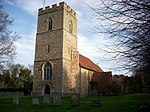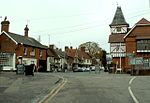Stansted Rural District
Stansted was a rural district in Essex, England from 1894 (1894) to 1934 (1934). It was created under the Local Government Act 1894 from the part of the Bishop's Stortford rural sanitary district which was in Essex (the rest becoming Bishop's Stortford Rural District in Hertfordshire). It consisted of the following parishes Berden Birchanger Elsenham Farnham Great Hallingbury Henham Little Hallingbury Manuden Stansted Mountfitchet UgleyThe district was wound up in 1934 under a County Review Order. The Hallingburys became part of Dunmow Rural District with the rest of the district joining Saffron Walden Rural District. Since 1974 it has formed part of the district of Uttlesford.
Excerpt from the Wikipedia article Stansted Rural District (License: CC BY-SA 3.0, Authors).Stansted Rural District
M11, Uttlesford Stansted Mountfitchet
Geographical coordinates (GPS) Address Nearby Places Show on map
Geographical coordinates (GPS)
| Latitude | Longitude |
|---|---|
| N 51.9 ° | E 0.22 ° |
Address
M11
CM24 8PN Uttlesford, Stansted Mountfitchet
England, United Kingdom
Open on Google Maps











